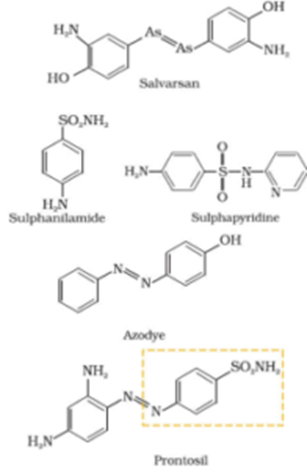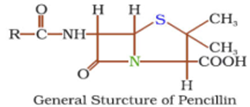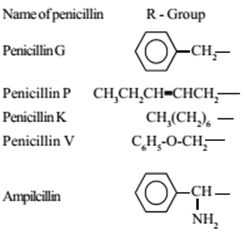Science > Chemistry > Everyday Chemistry > Everyday Medicines 02
In the last article, we have studied medicines in everyday life, like analgesics, antipyretics, antihistamines, tranquilizers, antifertility, and antimalarials. In this article, we shall study, antimicrobials, antibiotics, antiseptics, and disinfectants.
The action of Microbes in the Body:
The living organisms which cannot be seen with the naked eyes (unaided eyes) and can only be observed through a microscope are called microorganisms or microbes. They include bacteria, fungi, algae, and viruses. They are present almost everywhere air, water, soil, inside and on our body. The disease-producing microbes are called pathogens.
Our body has an efficient defense structure against these pathogens. Skin prevents microbes to enter our body. Some secretions like lysosomes in tears, nasal secretions, saliva, fatty acids, lactic acid in sweat, hydrochloric acid in stomach kill these microbes or inhibit their growth. The breach of this defense system allows the pathogens to reach tissues and cause infection in the body. Due to which normal metabolic activities are disturbed. This results in a disease. Pathogens produce toxins which may affect tissues and organs of the host.
Antimicrobials:
Antimicrobials are drugs which tend to destroy/prevent development or inhibit the pathogenic action of microbes such as bacteria (antibacterial drugs), fungi (antifungal agents), virus (antiviral agents), or other parasites (antiparasitic drugs) selectively. Antibiotics, antiseptics, and disinfectants are antimicrobial drugs.
The antimicrobials that kill bacteria are called bactericidal. Those inhibit the growth of bacteria are called bacteriostatic. Some antimicrobial increase immunity of the body. Germbacteriologistist Paul Ehrlich developed the first antimicrobial called arsphenamine (Salvarsan) for treatment of syphilis.
Sulpha drugs like sulphadiazine, sulphathiazole, sulphanilamide, sulphacetamide, sulphafurazole have great antibacterial power.

Antibiotics:
Antibiotics are used as drugs to treat infections because of their low toxicity for humans and animals. Initially, antibiotics were classified as chemical substances produced by microorganisms (bacteria, fungi, and molds) that inhibit the growth or even destroy microorganisms. The development of synthetic methods has helped in synthesizing some of the compounds that were originally discovered as products of microorganisms. Also, some purely synthetic compounds have antibacterial activity, and therefore, the definition of antibiotic has been modified. An antibiotic now refers to a substance produced wholly or partly by chemical synthesis, which at low concentrations inhibits the growth or destroys microorganisms by intervening in their metabolic processes.
The complete range of microorganisms which are attacked by an antibiotic is called a spectrum. The antibiotics effective against several different types of harmful microorganisms are called broad-spectrum antibiotics. e,g, Tetracycline, Chloramphenicol, etc.
In 1929 Alexander Fleming found antibacterial properties of a Penicillium fungus.

By substitution of different R groups, about 6 natural penicillins have been isolated so far. following five are from these 6 types.

Ampicillin and amoxicillin are semi-synthetic modifications of penicillin.
It is absolutely essential to test the patients for sensitivity (allergy) to penicillin or its modifications ampicillin and amoxicillin before it is administered.
In India, penicillin is manufactured at the Hindustan Antibiotics in Pimpri, at Indian Drugs and Pharmaceuticals Limited at IDPL Rishikesh and in private sector industry.
Types of Antibiotics:
Depending Upon Effect:
Antibiotics have either cidal (killing) effect or a static (inhibitory) effect on microbes. Depending upon these effects antibiotics are classified into two types bactericidal and bacteriostatic respectively.
- Examples of bactericidal antibiotics: Penicillin, Ofloxacin, Aminoglycosides, etc.
- Examples of bacteriostatic antibiotics: Erythromycin, Tetracycline, Chloramphenicol, etc.
Depending Upon Spectrum:
The range of bacteria or other microorganisms that are affected by a certain antibiotic is expressed as its spectrum of action. The complete range of micro-organisms attacked by an antibiotic is called spectrum.
- Antibiotics which kill or inhibit a wide range of Gram-positive and Gram-negative bacteria are said to be broad-spectrum antibiotics. Ampicillin and Amoxycillin are synthetic modifications of penicillin are broad spectrum Antibiotics. Other examples are tetracycline, chloramphenicol, vancomycin, ofloxacin.
- Antibiotics effective mainly against Gram-positive or Gram-negative bacteria are narrow spectrum antibiotics. e.g. Penicillin G5. Antibiotics effective against a single organism or disease, they are referred to as limited spectrum antibiotics.
Some Important Antibiotics:
Chloramphenicol is a broad spectrum antibiotic. It is rapidly absorbed from the gastrointestinal tract and hence can be given orally in case of typhoid, dysentery, acute fever, whooping cough, a certain form of urinary infections, meningitis, and pneumonia.

- Vancomycin and ofloxacin are the other important broad-spectrum antibiotics.
- The antibiotic dysidazirine is supposed to be toxic towards certain strains of cancer cells.
- Streptomycin is used for the treatment of tuberculosis. In low concentration it is bacteriostatic and in high concentration it is bactericidal.
- p-Aminosalicylic acid (PAS) and isonicotinhydrazine or isoniazid (INH) are also used for the treatment of tuberculosis.
Sulpha Drugs:
Sulpha drugs are derivatives of sulphanilamide. They were first introduced as medicine by Gerhard Domagk in 1930.

Sulphapyridine – Cure for pneumonia

Sulphadiazine – Cure for pneumonia, throat infection, meningitis,

Sulphaguanidine – Cure of bacillary dysentery

Sulphathiazole – Useful against staphylococcal infections and bubonic plague.

Succinyl sulphathiazole – Useful in intestinal infections such as bacillary dysentery and cholera)
Sulphaacetamide – Used to cure urinary tract infections.
Antiseptics:
Drugs which are applied to the living tissues to kill the bacteria and to stop their growth in
wound thus preventing its infection are called antiseptics.
Examples: Iodoform, boric acid, dilute solution of phenol, hydrogen peroxide. Dettol, tincture iodine, soframycin, furacine.
Antiseptics prevent the wound from infection. It is to be noted that antiseptics do not heal wounds. 2 to 3 % solution of iodine in alcohol and water is called tincture iodine. It is a powerful antiseptic and is applied to wounds.
Dettol is antiseptic and a mixture of terpineol and chloroxylenol.

Bithional (the compound is also called bithionol) is added to soaps to impart antiseptic properties.

Boric acid in dilute aqueous solution is weak antiseptic for eyes. Antiseptics are mixed with deodorants, face powders, and breath purifiers. Amyl meta-cresol is used as antiseptics in mouthwash or for gargling.
Uses of Antiseptics:
- They are used to dress the wounds.
- They are used to destroy fungal growth.
- They are used to sterilize surgical instruments.
- They are used in anti-infective in deodorants, shampoos and surgical soaps.
Disinfectants:
Drugs which are applied to the nonliving objects to kill the bacteria and to stop their growth are called disinfectants. They are not safe to be applied to living tissues.
Examples: Concentrated solution of phenol, sulphur dioxide, chlorine, Chlorine in the concentration of 0.2 to 0.4 ppm in aqueous solution. Sulphur dioxide in very low concentrations are disinfectants.
Uses of Disinfectants:
- They kill microorganisms on nonliving objects and used on public health floor and
to sterilize the surgical instruments.
Difference Between Antiseptics and Disinfectants:
Antiseptics:
- Drugs which are applied to the living tissues to kill the bacteria and to stop their growth in wound thus preventing its infection are called antiseptics.
- Antiseptics are applied to the living tissues such as wounds, cuts, ulcers and diseased skin surfaces.
Disinfectants:
- Drugs which are applied to the nonliving objects to kill the bacteria and to stop their growth are called disinfectants.
- Disinfectants are applied to inanimate objects such as floors, drainage system, instruments.
Important Discoveries in the Field of Medicine:
- Fellix Hoffman (German chemist) – Synthesis of Aspirin
- LeoSternbach (Polish Jewish chemist) – Discovered benzodiazepines (A class of tranquilizers)
- Selman Waksman (Jewish American biochemist) – Discovery of Streptomycin
- Alexander Fleming (Scotish pharmacologist) – Discovery of penicillin
- Paul Ehrich (German scientist) – a compound containing arsenic to treat syphilis, Discovered salvarsan and protonsil.
In the next article, we shall study the chemicals in food.
Next Topic: Use of Chemicals in Food
